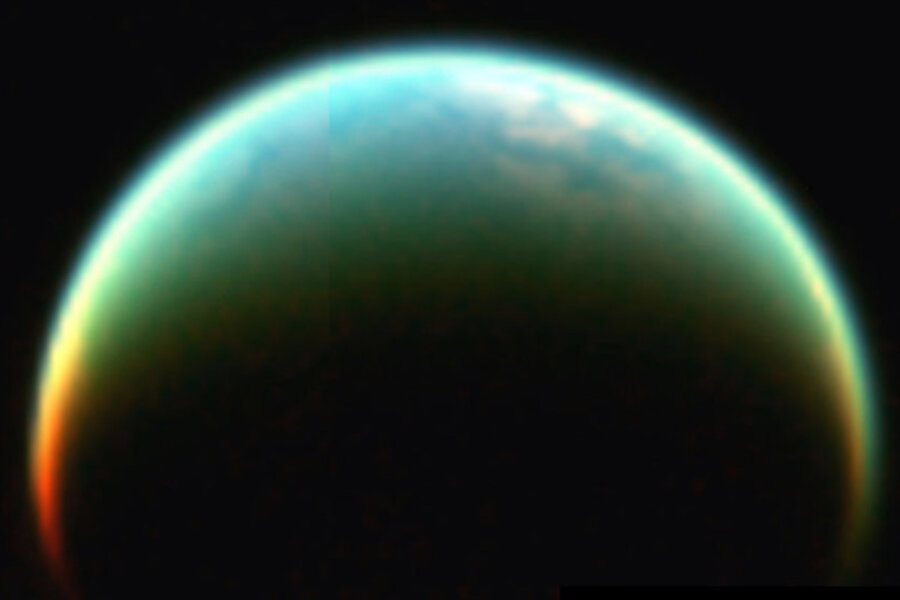Life on Saturn moon? Earth's asphalt lakes hint at possibility of life on Titan
Loading...
A lake of asphalt may be the closest thing on Earth to the hydrocarbon seas on Saturn's moon Titan, and it is apparently teeming with microbial life.
Not only could these findings help in the search for aliens in our own solar system, but they could provide insight into the evolution of life on this planet.
The largest naturally occurring asphalt lake on Earth is Pitch Lake on the Caribbean island of Trinidad, where black goo oozes across roughly 114 acres, an area slightly larger than that covered by Vatican City. Brimming as it is with hot asphalt and bubbling with carbon dioxide and hydrocarbon gases, Pitch Lake hardly seems fit for life.
However, scientists now find each gram of sticky black goo in Pitch Lake can harbor up to 10 million microbes, including bacteria as well as other single-celled organisms known as archaea. This life, which dwells in asphalt ranging between 90 to 132 degrees F (32 to 56 degrees C), apparently feeds off hydrocarbons. Instead of breathing oxygen, it respires with the aid of metals — perhaps iron or manganese.
The researchers collected six samples from the lake. "The tar itself sticks to everything — imagine really smelly molasses," said researcher Steven Hallam, a microbial systems ecologist at the University of British Columbia in Vancouver.
Each sample contained a distinct microbial population. Most of the bacteria appear related to ones found in oxygen-depleted sediments, methane seeps or oil reservoirs. However, some of the archaea they saw "fall far enough away from known groups as to represent novel lineages," Hallam said.
Water levels in the asphalt are low, at or below the reported threshold for life on Earth, so the life the researchers found in the lake might be constrained to watery pockets within the surrounding asphalt, similar to what is seen bound in frozen lakes and glaciers in the McMurdo Dry Valleys in Antarctica. The fact that E. coli gut bacteria can generate most of their own water and that fungus found in kerosene can extract water from light hydrocarbons could point to how life can survive even when little to no liquid water is available.
Aside from the very cold surface conditions on Titan, the environmental conditions within Pitch Lake are one of the closest copycats for that moon that we can find on our planet. The discovery of a broad spectrum of microbes in this lake enhances the possibility for life in Titan's hydrocarbon seas, researchers said. Some of Titan's hydrocarbon reservoirs might be heated from below, providing energy that potentially enhances the possibility of at least the precursor molecules for life.
"An obvious future step is to look at the adaptation mechanisms of these microbes and how they manage to make a living in Pitch Lake, which will give us also some idea of possible adaptation mechanisms for putative extraterrestrial life on Titan," said researcher Dirk Schulze-Makuch, an astrobiologist at Washington State University who also is involved in this project.
The prospect of life on Titan is exciting "because if we find life there, it most likely would be of a separate origin, which would greatly inform us how diverse life truly can be and would also greatly increase the chances of finding life outside of our solar system," Schulze-Makuch added.
Future research could tease out the genes these microbes rely on to live off the hydrocarbons and metal in this asphalt. Doing so could shed light on potential alien life, and even lead to new life-detection tests that look for a broader array of biomarkers.
This research also could be useful in the quest to make energy sources on Earth less polluting. Hallam said their study could lead to ways "to manufacture microbial treatment systems for cleaner fuel processing or the development of harvesting approaches that focus on the recovery of natural gas, a by-product of oil degradation."
Microbial life had earlier been detected in the La Brea Tar Pits in Los Angeles, although that research "was more focused on the biodegradation properties and biotechnological aspects of the system," Hallam noted. Also, while the bacteria in Pitch Lake and La Brea have similarities, the archaea populations at Pitch Lake appear more diverse.
Such research into asphalt lakes on Earth doesn't only give hints as to what life might be elsewhere in the universe, but also what it might have been like in the ancient past on our planet before it adapted to oxygen. "It's primordial in that sense," Hallam said.
The scientists note this miniature version of Titan on Earth is shrinking due in part to asphalt mining for road-paving operations. "It is a delicate balance between the need to conserve such an interesting natural laboratory and the economic development of the island," Hallam added. "It would be something if there were a way to promote ecotourism to the site."
The scientists have submitted their findings to the journal Astrobiology.





